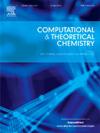First-principles study on single-layer electronic structure of Fe-doped MoS2 and the reduction of NO on the doped surface
IF 3
3区 化学
Q3 CHEMISTRY, PHYSICAL
引用次数: 0
Abstract
Electrocatalytic reduction represents an effective approach for the conversion of the harmful gas nitric oxide (NO) into ammonia (NH3), a vital chemical precursor in industrial production. However, the large-scale practical application of NO electrocatalytic reduction remains a significant challenge, particularly in the identification of efficient, low-cost, and stable catalysts. In this study, we investigate the electronic structure, magnetic properties, and stability of the Fe-MoS2 doping system using first-principles calculations. We explore the activation mechanism of NO molecules by Fe-MoS2 and assess its potential as an electrocatalyst for NO reduction by examining the electronic structure of the adsorbed states. Our results show that Fe doping effectively modulates the electronic structure of MoS2, significantly enhancing its capacity to adsorb NO compared to pristine molybdenum disulfide surfaces. Analysis of charge transfer and electronic properties during NO adsorption reveals a charge transfer of 0.32e between the substrate and the adsorbed NO molecule. Furthermore, the 2p and 2p orbitals of the nitrogen atom exhibit partial overlap with the 3d, 3d, and 3d orbitals of the Fe atom near the Fermi level, indicating strong interactions that facilitate NO activation. The hydrogenation process of NO to ammonia was further investigated using two different approaches. The results demonstrated the exceptional electrocatalytic reduction activity of Fe-doped S vacancy towards NO. This study not only provides a concise depiction of the Fe-MoS2 electrocatalyst but also verifies the feasibility of utilizing Fe-MoS2 for the electrocatalytic synthesis of ammonia from NO.

fe掺杂MoS2的单层电子结构及掺杂表面NO的还原第一性原理研究
电催化还原是将有害气体一氧化氮(NO)转化为氨气(NH3)的有效方法,而氨气是工业生产中的重要化学前体。然而,氮氧化物电催化还原的大规模实际应用仍然是一个重大挑战,特别是在确定高效、低成本和稳定的催化剂方面。在本研究中,我们利用第一原理计算研究了掺杂 Fe-MoS2 系统的电子结构、磁性能和稳定性。我们探索了 Fe-MoS2 对 NO 分子的活化机制,并通过研究吸附态的电子结构评估了其作为 NO 还原电催化剂的潜力。我们的研究结果表明,与原始二硫化钼表面相比,掺杂铁能有效调节 MoS2 的电子结构,显著增强其吸附 NO 的能力。对 NO 吸附过程中电荷转移和电子特性的分析表明,基底和被吸附的 NO 分子之间的电荷转移为 0.32e。此外,氮原子的 2py 和 2px 轨道与费米级附近铁原子的 3dxy、3dyz 和 3dxz 轨道有部分重叠,这表明存在着促进 NO 活化的强烈相互作用。研究人员采用两种不同的方法进一步研究了 NO 向氨的氢化过程。结果表明,掺杂铁的 S 空位对 NO 具有优异的电催化还原活性。这项研究不仅简明地描述了 Fe-MoS2 电催化剂,还验证了利用 Fe-MoS2 电催化从 NO 合成氨的可行性。
本文章由计算机程序翻译,如有差异,请以英文原文为准。
求助全文
约1分钟内获得全文
求助全文
来源期刊

Computational and Theoretical Chemistry
CHEMISTRY, PHYSICAL-
CiteScore
4.20
自引率
10.70%
发文量
331
审稿时长
31 days
期刊介绍:
Computational and Theoretical Chemistry publishes high quality, original reports of significance in computational and theoretical chemistry including those that deal with problems of structure, properties, energetics, weak interactions, reaction mechanisms, catalysis, and reaction rates involving atoms, molecules, clusters, surfaces, and bulk matter.
 求助内容:
求助内容: 应助结果提醒方式:
应助结果提醒方式:


